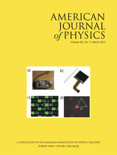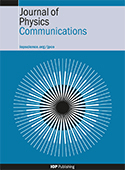
PHYSICS WORLD
Scope & Guideline
Empowering Research, Inspiring Discovery
Introduction
Aims and Scopes
- Interdisciplinary Research:
The journal promotes research that crosses traditional boundaries, integrating physics with fields such as biology, chemistry, and environmental science. This interdisciplinary approach enhances the applicability of physics in solving real-world problems. - Emerging Technologies:
A significant focus on emerging technologies, particularly in quantum computing, renewable energy, and advanced materials, reflects the journal's commitment to exploring the future of physics and its potential societal impacts. - Educational Outreach:
Through articles aimed at educators and students, PHYSICS WORLD emphasizes the importance of physics education and the need for innovative teaching methods, thereby contributing to the development of future generations of physicists. - Public Engagement:
The journal actively engages with the public by simplifying complex physics topics and making them accessible to a broader audience, thus enhancing public interest and understanding of science. - Policy and Ethics in Physics:
Discussion of ethical issues and policy implications related to scientific research is a recurring theme, highlighting the journal’s role in addressing the societal responsibilities of physicists.
Trending and Emerging
- Quantum Technologies:
Recent publications highlight a surge in research related to quantum technologies, including developments in quantum computing and quantum communication, reflecting a growing interest in harnessing quantum mechanics for practical applications. - Climate Change and Sustainability:
The journal has increasingly published articles addressing the physics of climate change, renewable energy solutions, and sustainable technologies, showcasing the role of physics in tackling global environmental challenges. - Interdisciplinary Approaches to Health and Medicine:
Emerging themes focus on the intersection of physics with healthcare, such as medical physics and biophysics, emphasizing the importance of physics in advancing medical technologies and improving patient outcomes. - Data Science and Machine Learning:
The integration of data science and machine learning techniques in physics research is gaining traction, with articles exploring how these methods can enhance research outcomes and experimental analyses. - Social Responsibility and Ethics in Physics:
An increasing number of articles discuss the ethical implications of physics research and the responsibilities of scientists, indicating a growing awareness of the societal impacts of scientific advancements.
Declining or Waning
- Traditional Physics Education:
There has been a noticeable decrease in articles focusing solely on traditional physics education methods, as the journal increasingly prioritizes innovative and interdisciplinary approaches to teaching. - Pure Theoretical Physics:
Topics centered solely around abstract theoretical physics have seen reduced coverage, indicating a shift towards more applied and interdisciplinary research that addresses practical challenges. - Historical Perspectives on Physics:
While history remains an important aspect of science, articles that delve deeply into historical accounts and perspectives of physics have become less common, suggesting a move towards contemporary issues and future-oriented research. - Basic Research in Isolated Fields:
There is a waning focus on basic research in isolated fields of physics, as the journal emphasizes the integration of physics with other disciplines and practical applications. - Niche Areas of Research:
Certain niche areas of physics that previously received attention may now be overshadowed by more pressing global challenges, such as climate change and technological advancement.
Similar Journals

TECHNICAL PHYSICS LETTERS
Exploring New Dimensions in Scientific ResearchTechnical Physics Letters, an esteemed publication of MAIK Nauka/Interperiodica/Springer, serves as a pivotal platform for advancing the field of physics and astronomy since its establishment in 1996. This journal, with its ISSN 1063-7850 and e-ISSN 1090-6533, not only publishes high-quality research articles but also encourages innovative discussions and practical applications within the diverse realms of technical physics. With a solid reputation reflected in its Q3 category ranking within the broader physics and astronomy landscape, it aims to connect researchers and professionals who seek to address contemporary challenges and encourage multidisciplinary approaches to complex scientific problems. Although the journal does not currently offer open access options, it remains accessible to a wide readership, fostering a collaborative spirit among the scientific community. As it converges its efforts from 1996 to 2024, Technical Physics Letters is poised to be an essential resource for anyone looking to stay at the forefront of physics research.

PHYSICS TODAY
Fostering Insight and Innovation in PhysicsPHYSICS TODAY is a prestigious journal published by the American Institute of Physics, serving as a pivotal platform for the dissemination of innovative research and developments in the field of physics and astronomy. With an ISSN of 0031-9228 and an E-ISSN of 1945-0699, this journal has been in circulation since 1948 and is set to continue until 2024. Recognized for its substantial contributions to the scientific community, PHYSICS TODAY holds a significant position within the Q2 quartile of the Physics and Astronomy category as of 2023. Although it does not offer open access, its articles remain crucial resources for researchers, professionals, and students seeking to stay abreast of the latest advancements across a broad range of topics in general physics and astronomy. With a current Scopus ranking of #150 out of 243 and a percentile standing at 38, the journal bolsters its reputation as a reliable source for high-quality scientific discourse. In an era of rapid scientific advancement, PHYSICS TODAY remains dedicated to fostering a deeper understanding of the physical universe, making it an essential read for those invested in the future of physics.

REPORTS ON MATHEMATICAL PHYSICS
Pioneering Discoveries in Mathematical PhysicsREPORTS ON MATHEMATICAL PHYSICS is a distinguished journal published by PERGAMON-ELSEVIER SCIENCE LTD, focusing on the intricate interplay between mathematics and physics. Established in the United Kingdom, this journal has been contributing to the academic community since its inception, publishing significant research findings that explore the theoretical underpinnings of physical phenomena. With an ISSN of 0034-4877 and an E-ISSN of 1879-0674, the journal maintains a consistent publishing history, converging research from 1970 to 2024. It is currently ranked Q3 in both Mathematical Physics and Statistical and Nonlinear Physics categories, reflecting its commitment to maintaining a high standard of scholarly work. Although it lacks Open Access options, its targeted audience of researchers, professionals, and students will find invaluable insights into advanced mathematical methods, statistical applications, and innovative approaches in physics. With its esteemed reputation and critical role in the field, REPORTS ON MATHEMATICAL PHYSICS continues to be an essential resource for those seeking to deepen their understanding of mathematical applications in physical systems.

Results in Physics
Connecting Researchers, Elevating PhysicsResults in Physics, an esteemed open-access journal published by ELSEVIER, has been a prominent platform for disseminating cutting-edge research in the field of physics since its establishment in 2011. With its ISSN 2211-3797 and E-ISSN 2211-3797, this journal proudly holds a Q2 ranking in the Physics and Astronomy category for 2023, showcasing its significance and quality within the scientific community. With a remarkable Scopus rank of #28 out of 243 in the general physics and astronomy domain, placing it within the 88th percentile, Results in Physics serves as a vital resource for researchers, professionals, and students alike, fostering a collaborative environment for the advancement of knowledge across various subfields. The journal aims to provide a rapid and unrestricted access to innovative findings, encouraging open scientific dialogue and enhancing the visibility of breakthrough research. Located in the Netherlands at RADARWEG 29, 1043 NX AMSTERDAM, Results in Physics continues to uphold its commitment to excellence and accessibility in the ever-evolving landscape of physics research.

Nuovo Cimento C-Colloquia and Communications in Physics
Bridging Ideas in Astronomy and PhysicsNuovo Cimento C-Colloquia and Communications in Physics is a distinguished peer-reviewed journal published by the SOC ITALIANA FISICA, dedicated to the dissemination of novel research and communications in the vibrant fields of Astronomy and Physics. Established in 1978, this journal provides a platform for scientists and researchers to present their findings, fostering academic dialogue and collaboration within the community. As of 2023, the journal holds a Q4 quartile ranking in both Astronomy and Astrophysics and Physics and Astronomy (miscellaneous), reflecting its commitment to contributing to the scientific corpus despite its emerging status in the competitive landscape. Based in Italy, the journal is accessible to a global audience, enhancing its reach and influence. Although currently not an open access journal, it remains an essential resource for researchers and professionals seeking to stay informed on cutting-edge developments in physics and astronomy. Its ongoing convergence of knowledge from 1978 to 2024 promises to enrich the scholarly discourse and advance the frontiers of research in these dynamic fields.

NEW JOURNAL OF PHYSICS
Connecting global minds through groundbreaking physics.NEW JOURNAL OF PHYSICS, published by IOP Publishing Ltd, is a prestigious open-access journal that has been at the forefront of the physics community since its inception in 1998. With an impact factor that places it in the Q1 category of Physics and Astronomy (miscellaneous) and a commendable ranking of #49 out of 243 in the general physics and astronomy category according to Scopus, this journal is recognized for its significant contribution to advancing research in the field. The journal caters to a broad scope of topics, providing a platform for the dissemination of cutting-edge research findings and innovative theoretical explorations. Operating from the United Kingdom, it offers a truly international perspective, making its contents accessible and impactful to a global audience. With robust open-access options, the NEW JOURNAL OF PHYSICS ensures that research findings are freely available, promoting collaboration and knowledge sharing among researchers, professionals, and students alike. This commitment to accessibility, combined with its high-quality content, makes it an essential resource for anyone engaged in the physics community.

JOURNAL OF THE PHYSICAL SOCIETY OF JAPAN
Elevating the Standards of Research Excellence in JapanThe JOURNAL OF THE PHYSICAL SOCIETY OF JAPAN, published by the Physical Society of Japan, has been at the forefront of advancing knowledge in the field of Physics and Astronomy since its inception in 1946. With a commendable reputation reflected in its Q2 ranking within its category for 2023, this journal serves as a vital platform for disseminating high-quality research and innovative concepts. Researchers and professionals alike can engage with cutting-edge studies and reviews that span a diverse range of topics pivotal to the physical sciences. Although the journal does not currently operate with an open access model, it maintains a robust impact on the global physics community, evidenced by its placement in the 59th percentile among a competitive pool of 243 journals. With an unwavering commitment to bridging theory and application, the JOURNAL OF THE PHYSICAL SOCIETY OF JAPAN continues to inspire and cultivate scholarly discourse and collaboration across disciplines.

European Physical Journal-Special Topics
Exploring the Frontiers of Physics and Materials ScienceThe European Physical Journal-Special Topics (EPJ ST), published by Springer Heidelberg, is an esteemed academic journal dedicated to the dissemination of high-quality research across various domains of physics and materials science. With an ISSN of 1951-6355 and E-ISSN 1951-6401, it serves as a platform for articles that delve into topical issues and emerging areas of interest. The journal consistently ranks in the upper quartiles of its categories, achieving Q2 in Materials Science, Q3 in Physical and Theoretical Chemistry, and Q2 in Physics and Astronomy for 2023. This underscores its significant impact in these fields, positioned well within percentile rankings that reflect its relevance and esteem among peers. With an impressive convergence from 2007 to 2024, EPJ ST not only contributes to theoretical advancements but also promotes collaborative research through its open-access options. Ultimately, it serves as an essential resource for researchers, professionals, and students pursuing innovative insights and advancements in physics and materials science.

AMERICAN JOURNAL OF PHYSICS
Connecting Tradition with Innovation in Physics.The American Journal of Physics (ISSN: 0002-9505, E-ISSN: 1943-2909), published by AIP Publishing, has been a cornerstone in the realm of physics education and research since its inception. With a broad scope that covers a plethora of topics in physics and astronomy, this journal serves as a vital resource for researchers, educators, and students alike, aiming to foster a deeper understanding of the fundamental principles of physics. As of 2023, it holds a commendable Q2 ranking in Physics and Astronomy (miscellaneous), reflecting its impactful contributions and rigorous peer-review process. Although the journal does not offer open access, it continues to be widely circulated, ensuring that groundbreaking research is accessible to a dedicated audience. The convergence of historical insights and contemporary advancements makes the American Journal of Physics an essential publication for those striving to stay at the forefront of the field.

Journal of Physics Communications
Transforming Research into Impactful InsightsJournal of Physics Communications, published by IOP Publishing Ltd, serves as a significant platform for the dissemination of innovative research in the realm of physics and astronomy. Since its inception in 2017, this Open Access journal has fostered a collaborative environment, allowing researchers, professionals, and students to share their findings and ideas without barriers. With an ISSN of 2399-6528, the journal has established its credibility in the academic community, achieving a ranking of Q3 in the 2023 category of Physics and Astronomy (miscellaneous), as well as a respectable position in Scopus with a rank of #122 out of 243 in its field. The journal's focus is on bridging theoretical concepts and practical applications, making it an essential resource for those engaged in the evolving landscape of physics. The Journal of Physics Communications not only aims to advance knowledge but also to inspire interdisciplinary collaboration, inviting contributions from diverse areas within physics. Authors and readers alike will find this journal particularly beneficial to stay updated on emerging trends and innovative research.